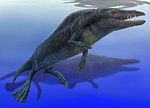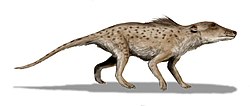Archaeoceti
| Archaeoceti Status i världen: Fossil Stratigrafisk utbredning: Eocen-Oligocen | |
 Skelett av Archaeoceten Maiacetus på National Museum of Natural History. | |
| Systematik | |
|---|---|
| Domän | Eukaryoter Eukaryota |
| Rike | Djur Animalia |
| Stam | Ryggsträngsdjur Chordata |
| Understam | Ryggradsdjur Vertebrata |
| Klass | Däggdjur Mammalia |
| Ordning | Valar Cetacea |
| Underordning | Archaeoceti |
| Vetenskapligt namn | |
| § Archaeoceti | |
| Auktor | Flower, 1883 |
 Diagram över den daterade åldern på ett antal släkten inom Archaeoceti | |
| Hitta fler artiklar om djur med | |
Archaeoceti ("Forntida valar") är en taxonomisk grupp som idag ofta definieras som en underordning till ordningen valar (Cetacea) och som inkluderar primitiva valar och de landlevande däggdjur som tros vara deras förfäder.[1] Hela gruppen är idag utdöd.
Taxonomi och evolution
Tidigare trodde många forskare att valarna utvecklades ur en grupp med köttätande hovdjur, Mesonychierna, som påminde om dagens hunddjur och vargar. Senare fossila fynd och molekylärbiologiska studier har dock indikerat att valar är närmare släkt med de partåiga hovdjuren (Artiodactyla),[2][3] vilket resulterar i att Mesonychier och valar betraktas som mer avlägset besläktade.
De äldsta fossil som tros vara från Archaeoceti är landlevande djur som beräknas vara cirka 55-45 miljoner år gamla. Dessa inkluderar Pakicetus och Nalacetus, som tros ha liknat hunddjur till formen. Därefter tror forskarna att Archaeoceti under årmiljonerna anpassade sig alltmer till ett liv i vatten. Sådana djur inkluderar Ambulocetus, Maicateus, Rodhocetus och Remingtonocetus. De äldsta fynden av marina valar tros vara 47-45 miljoner år gamla varav Protocetus, Zygorhiza, Cynthiacetus och Zeuglodon är några av dessa.
Släkten
Överordning Laurasiatheria
- taxonomisk obestämd grupp Cetartiodactyla
- Ordningen valar (Cetacea)
- Underordningen Archaeoceti
- Familj Pakicetidae
- Pakicetus
- Nalacetus
- Ichthyolestes
- Familj Ambulocetidae
- Ambulocetus
- Gandakasia
- Himalayacetus
- Familj Remingtonocetidae
- Andrewsiphius
- Attockicetus
- Dalanistes
- Kutchicetus
- Remingtonocetus
- Familj Protocetidae
- Artiocetus
- Rodhocetus
- Underfamilj Indocetinae
- Georgiacetus
- Underfamilj Protocetinae
- Maiacetus
- Protocetus
- Familj Basilosauridae
- Underfamilj Basilosaurinae
- Underfamilj Dorudontinae
- Zygorhiza
- Dorudon
- Familj Pakicetidae
- Underordningen Archaeoceti
- Ordningen valar (Cetacea)
Skelett av Ambulocetus
Illustration av simmande Rodhocetus
Källor
- ^ Archaeoceti. A Dictionary of Zoology. Encyclopedia.com. läst 15 augusti 2018.
- ^ Gatesy, J., Hayashi, C., Cronin, A., and Arctander, P. (23 september 1996). ”Evidence from milk casein genes that cetaceans are close relatives of hippopotamid artiodactyls”. Molecular Biology and Evolution "13" (7): ss. 954–963. PMID 8752004.
- ^ dailynews.yahoo: Fossil Find Show Whales Related to Early Pigs Arkiverad 21 september 2001 hämtat från the Wayback Machine..
Referenser
- Den här artikeln är helt eller delvis baserad på material från engelskspråkiga Wikipedia, 3 april 2010.
|
Media som används på denna webbplats
Författare/Upphovsman: Conty, Licens: CC BY 3.0
Diagram showing geological ages of different Archaeocetei genera. Coloured diamonds represent absolute dates, coloured lines indicate the geological age is less certain. White diamonds (see Pakicetus and the basilosaur specinen MLP 11-II-21-3) represent previously proposed dates which subsequently have been considered inaccurate. Body silhouettes showed in diagram represent Pakicetus, Ambulocetus, Qaisracetus, Aegicetus and Dorudon.
Pakicetidae are primarily found in the lower Kuldana Formation,[1] but have also been found further up, with some species of Pakicetus overlapping the geological range of the remingtonocetid Attockicetus.[2]
- Pakicetus was previously dated to 52 million years,[3] but have subsequently been dated to 48 million years.[4]
- Ichthyolestes is contemporaneous to Pakicetus.[2]
- Nalacetus is contemporaneous to Pakicetus.[2]
Ambulocetidae is estimated to have lived about 52-49 million years ago.[5]
- Himalayacetus is dated to 53.5 million years.[4]
- Gandakasia stems from a layer below the remains of Ambulocetus.[2]
- Ambulocetus is dated to 48-47 million years.[6]
Remingtonocetidae is dated to 49-43 million years ago.[5]
- Dalanistes dates to 46.5-46 million years ago.[7]
- Remingtonocetus dates to 46.5-46 million years ago.[7]
- Kutchicetus dates to 46-43 million years ago.[5] fossil remains stem from Harudi Formation in India, considered to be from the Lutetian, about 46-42 million years (or possibly 43-41 million years).[8]
- Andrewsiphius fossil remains stem from Harudi Formation in India, considered to be from the Lutetian, about 6-42 million years (or possibly 43-41 million years).[8]
- Attockicetus fossil range in Kuldana Formation overlap with late Pakicetus and precede as well as exceed that of Ambulocetus.[2]
- Rayanistes[9]
Protocetidae consist of several genera spanning the Middle Eocene, roughly 49-37 million years ago.[10]Aegicetus expand the ending date to 35 million years ago.
- Maiacetus is the oldest protocetid, dated to 47.5 million years.[10]
- Artiocetus 47 million years.[6]
- Rodhocetus 47-46.5 million years.[11][6]
- Tacracetus 46.5-46 million years[7] (not included in the diagram).
- Gaviacetus 46.5-46 million years.[7]
- Protocetus 46-45 million years.[11]
- Qaisracetus have been given a date of 43 million years.[12]
- Peregocetus 42.6 million years.[13]
- Natchitochia are known from fossils dug up in Louisiana, USA. The holotype fossil (USNM 16805) was found in Milams members layers of Cook Mountain Formation[14] (dated to Early Bartonian).[15] The Milams members layers is believed to have been laid down 41.3-39.5 million years ago.[16] The specimen MMNS VP-48-49 was found in the lowest part of the Milams (Archusa Marl member).[17] This would give it a date of about 41 millon years.
- Aegypteocetus is dated to 41-40 million years[18]
- Georgiacetus has been given dates of 41-40 million years[19] or 41-38 million years.[5]
- Aegicetus is the protocetid with the most recent date of 35 million years.[20]
Basilosauridae have been dated to 40-34 million years,[10] with the Priabonian Cynthiacetus and Saghacetus as the most recent genera.[21] An isolated jawbone (MLP 11-II-21-3) found at Seymour Island (Antarctica) in 2011 could potentially push back the temporal rage of the family.[22]
- MLP 11-II-21-3 is a specimen consisting of a single jawbone found in Antarctica. It was first said to be 49 million years,[23] but it has been difficult to decide an age of the rocks in which it was found.[22] In 2019, it was given an age of 46-40 million years.[24]
- USNM 310633 (dated to 42 million years)[25] was originally described as a protocetid and named Eocetus wardii by Mark Uhen 1999.[26]It was re-classified in 2013 to a new genus of basilosaurid, Basilotritus,[27] and subsequently to Pachycetus[28]
- Tutcetus have been dated to the Early Bartonian (41 million years ago) and described as "one of the oldest [basilosaurid] records worldwide".[29]
- Basilosaurus fossils have been assigned to the Priabonian and Bartonian stages of Eocene, 40-37 million years ago.[6][30]
- Perucetus have been dated to 38 million years.[31]
- Dorudon are stated by some sources to be 37 million years old,[6] while others gives a date of 41-40 million years.[32]
References
- ↑ [1]
- ↑ a b c d e [2]
- ↑ [3]
- ↑ a b [4]
- ↑ a b c d Thewissen J.G.M. & Bajpai S, 2001, “Whale Origins as a Poster Child for Macroevolution”, BioScience 51(12): p. 1037-1049
- ↑ a b c d e [5]
- ↑ a b c d [6]
- ↑ a b [7]
- ↑ [8]
- ↑ a b c Gingerich P.G. et.al. (2009). "New Protocetid Whale from the Middle Eocene of Pakistan: Birth on Land, Precocial Development, and Sexual Dimorphism". PLoS ONE 4(2): e4366
- ↑ a b [9]
- ↑ [10]
- ↑ [11]
- ↑ Uhen M.D. (1998). "New protocetid (Mammalia, Cetacea) from the late middle Eocene Cook Mountain Formation of Louisiana", Journal of Vertebrate Paleontology 18(3): p. 664-668
- ↑ [12]
- ↑ [13], diagram at p. 7
- ↑ Uhen M.D. (2014). "New material of Natchitochia jonesi and a comparison of the innominata and locomotor capabilities of Protocetidae", Marine Mammal Science 30(3): p. 1029-1066
- ↑ [14]
- ↑ [15]
- ↑ [16]
- ↑ [17]
- ↑ a b [18]
- ↑ [19]
- ↑ [20]
- ↑ Geisler J.H., Sanders A.E. & Lou Z-X. (2005). "A New Protocetid Whale (Cetacea: Archaeoceti) from the Late Middle Eocene of South Carolina", American Museum Novitates no. 3480: p. 1-65
- ↑ Uhen M. (1999). "New Species of Protocetid Archaeocete Whale, Eocetus wardii (Mammalia: Cetacea) from the Middle Eocene of North Carolina". Journal of Paleontology 73(3): p. 512-528
- ↑ Gol'din P & Zvonok E.A. (2013). "Basilotritus uheni, a New Cetacean (Cetacea, Basilosauridae) from the Late Middle Eocene of Eastern Europe". Journal of Paleontology 87(2): p. 254-268
- ↑ van Vliet H.J., Bosselaers M, Vahldiek B-W., Paymans T & Verheijen I (2020). "Eocene cetaceans from the Helmstedt region, Germany, with some remarks on Platyosphys, Basilotritus and Pachycetus", Cainozoic Research 20(1): p. 121-148
- ↑ Antar M.S. et.al. (2023). "A diminutive new basilosaurid whale reveals the trajectory of the cetacean life histories during the Eocene". Communications Biology 6:article 707
- ↑ The Paleobiology Database: "Basilosaurus" (read 29-11-2020)
- ↑ Bianucci G et.al.. "A heavyweight early whale pushes the boundaries of vertebrate morphology". Nature (published online 2/8/2023)
- ↑ Uhen M.D. (2004). "Form, Function, and Anatomy of Dorudon Atrox (Mammalia, Cetacea): An Archaeocete from the Middle to Late Eocene of Egypt". The University of Michigan Museum of Paleontology Papers on Paleontology 34: 222 pages
Författare/Upphovsman: Cliff from Arlington, VA (Outside Washington DC), USA, Licens: CC BY 2.0
Maiacetus, National Museum of Natural History, USA
Författare/Upphovsman: Thesupermat, Licens: CC BY-SA 3.0
Ambulocetus au premier plan et Pakicetus au second plan
Författare/Upphovsman: Nobu Tamura (http://spinops.blogspot.com), Licens: CC BY 3.0
Pakicetus inachus, a whale ancestor from the Early Eocene of Pakistan, after Nummelai et al., (2006), pencil drawing, digital coloring









